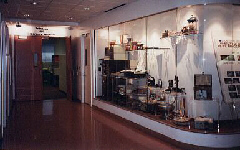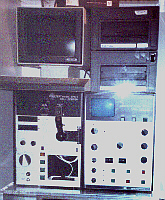Dr. Dave's Museum
Background | Whazzat Thang? | Solution to Last Thang | Thang Archive | Links

visitors since 22 June 1998
Background | Whazzat Thang? | Solution to Last Thang | Thang Archive | Links

visitors since 22 June 1998
The Department of Pathology and Laboratory Medicine at Mount Sinai Hospital in Toronto, Ontario, Canada built new offices a few years ago, using space which had been a storeroom for old lab equipment. The resulting problem: What to do with the displaced relics?

My colleague Dr. Dave was put in charge of a project to create a departmental museum. He spent more than a few hours selecting items to move into the glass case. The function of many of these interesting pieces wasn't immediately obvious to us.
I have run out of thangs! Not that medical laboratory science is no longer progressing -- new and better equipment is always being introduced. I just don't have any more images to post here. I hope you have enjoyed and learned something from "Whazzat Thang". If this is your first visit to the Dr. Dave's Museum page, please have a look at the Ole Thangs!
"Whazzat Thang?"
(--TH, March 1999)
Send me your comments about
Whazzat Thang?
E-mail: thiruki@ipns.com
============== Solution to the Last Thang ==============
Unknown Thang #7 - January-March 1999
 Guess(es) Received:I can recognize some things; a monitor and keyboard (upper left), and two 8-inch floppy drives (upper right). This implies a computer of some kind, so one of the two boxes below has to be the main body. I'm guessing it's a late 1970's vintage. I see what appears to be a small CRT on the lower right unit, but it seems redundant, given the bigger one above. As to the function, I'm guessing that it is an analyzer of some sort. A spectral analyzer? The (liquid?) sample would be inserted into the slot at the lower left, tubes inserted and drawn through the machine, and results displayed. The selector knob allows different 'tests' to be performed. The black lever (or what appears to be a lever) on the front is a bit of a mystery to me.
Guess(es) Received:I can recognize some things; a monitor and keyboard (upper left), and two 8-inch floppy drives (upper right). This implies a computer of some kind, so one of the two boxes below has to be the main body. I'm guessing it's a late 1970's vintage. I see what appears to be a small CRT on the lower right unit, but it seems redundant, given the bigger one above. As to the function, I'm guessing that it is an analyzer of some sort. A spectral analyzer? The (liquid?) sample would be inserted into the slot at the lower left, tubes inserted and drawn through the machine, and results displayed. The selector knob allows different 'tests' to be performed. The black lever (or what appears to be a lever) on the front is a bit of a mystery to me.--Tak Ariga, Toronto ON, Sat, 27 Feb 1999 11:26:08
================== A N S W E R ==================
This is an early Coulter Counter, a device for automatically enumerating the numbers of different types of cells in a sample of blood. It is related to Ole Thang #6 in that this is the machine that all but eliminated the need for doing red blood cell counts and differential white blood cell counts by hand (except in special circumstances).The Coulter Principle is central to the function of the Coulter Counter. Basically, it differentiates the various types of cells that make up blood on the basis of their relative electrical charges. The sample is sucked into the counter through one of the tubes in the slot at lower left, and the counted fluid is expelled throught the other tube.
Using the Coulter Counter The Coulter Counter was developed during the late 1950s. This machine from the 1970s is calibrated visually through a microscope eyepiece (the black "lever" on the front). Have a look at the patent papers of a similar machine. Several thousand particles per second are individually counted and sized with great accuracy, many more cells than was possible by hand. The "real time" shape of the data of the sample running though the machine is displayed on the small CRT (lower right). The data is stored on a computer (the monitor, keyboard and floppy drives in the upper half of image).
The Coulter Counter revolutionized the Complete Blood Count (CBC), the standard first blood test of most medical workups. The qualities of blood could be observed in a rapid, objective, quantitative way. Today's Coulter Counters are much more compact, and have semi-automatic calibration.
Related Links
Wallace Coulter
Read about the inventor of the Coulter counter, a remarkable man who died in 1998 at the age 85
Automated Cell Analysis by Michael Dockter
A detailed explanation of cell counting
Flow cytometry
Another approach to cell sorting, except that it identifies particles by the degree they scatter a laser beam, as well as fluorescence characteristics, if fluorescent dyes and labels are used.Tak Ariga's uncannily close guess is good enough to win!
(What, I'm not sure ... a tour of Pacific Northwest breweries?)"Thangks" for your guess!
See MORE THANGS!
Medical History Museum of Nova Scotia Halifax-Dartmouth NS, Canada
Pathology History Links
Laboratory Medicine 75 Years Ago
The American Society of Clinical Pathology celebrated its 75th anniversary in 1997
National Museum of Health and Medicine Bethesda MD
Medical Antiques
Surgical, medical and dental instruments from the 1800s to the early 1900s
Medical Instruments Museum
Museum of Questionable Medical Devices Quackery or medicine? Time tells ...
Old Microscopes and Optical Devices from Media Specialties
International Bibliographic Guide to the History of Pathology
View guestbook | Sign guestbook Last updated 23 October 1999
[HOME]